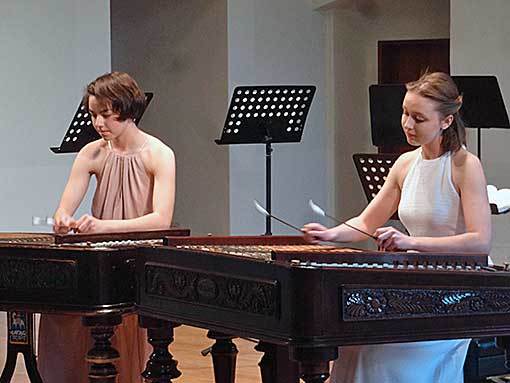The song Malované na cimbál by Dalibor Štrunc lent its name to the concert and the new CD. It is one of the most mature and at the same time the most promising fruits of the boom of dulcimer music in Moravia.
A remarkable concert took place in the hall of the Convent of Merciful Brothers in Brno on 18 May. Its unifying element was the personality of Dalibor Štrunc – dulcimer player, artist, active musician, composer and educator. The latter two roles have reached their peak so far and resulted in an outcome extremely impressive for the audience at the Malované na cimbál concert at the Brno Convent. The programme included Štrunc's original songs performed by three of his female students Kateřina Harnošová, Anna Múčková and Barbora Jagošová (seconded by oboist Jaroslava Tajanovská in the song Hlasy modrých stromů). They were accompanied by the student Moravian Chamber Orchestra under the leadership of Richard Kružík.
The atmosphere of the evening was enhanced by the introduction of the successful CD of the same name containing music that was featured in the programme. The author of the lyrics contributed to the CD as the co-author of the accompanying words and consultant – partly out of friendship for the author, but also from the deep conviction that something new is being created. Even so, I must mention the interpretive levels and the apparently joyful performance of all young musicians involved. Something was born that Brno can be proud of, and if the city were a company, it could proudly export. The audience appreciated the performances of everyone - the author and the musicians – with a well-deserved long applause.
Dynamic instrument and its protagonists
In Moravia, the dulcimer is an unmistakable phenomenon and it seems that its effects are intensifying. Two personalities were in the audience at the Brno concert who belong to the icons of the local dulcimer music: Helena Červenková was an excellent and mode soloist in BROLN for decades, Růžena Děcká still works as an extremely productive teacher, whose classes have raised personalities such as Daniel Skála or Petr Pavlinec. Professor Děcká stood at the beginnings of the prestigious International Dulcimer Festival in Valašské Meziříčí. Together with Helena Červenková, they have been active in the World Dulcimer Association, which promotes our talents, for many years. They are personalities, on whose "back" the current generation of excellent players, composers and educators, who work throughout Moravia, grew up.
Dalibor Štrunc is at the forefront of this generation, and he has already established another one – the excellent young players Jiří Gužík and Petr Gablas graduated from his class. After them, there was a wave of girls in his class and the students also performed at this concert – they are capable of fully professional performance already during their studies. One of the young dulcimer players, Anna Múčková, will perform the song Malované na cimbál in Rudolfinum in Prague➚ accompanied by the Prague Youth Philharmonic. The original work of younger composers is shifting along with this movement, and Štrunc's songs from the CD Malované na cimbál can do a lot to spread the reputation of this instrument.
Dulcimer player Dalibor Štrunc, who turned 50 this year, has "touched" the dulcimer from all sides during his musical career. The native of Rožnov pod Radhoštěm built a relationship with Wallachian folk music through his parents. He entered the professional level of dulcimer music after graduating from the Brno Conservatory. He worked in the Czechoslovak State Song and Dance Ensemble in Prague and later in the Brno Radio Orchestra of Folk Instruments. In addition, he gradually cooperated with a number of professional ensembles (e.g. Prague Symphony Orchestra, Brno Philharmonic Orchestra, Südwestdeutsche Philharmonie Konstanz and more) and recorded film music.
He also started his own band Cimbal Classic, which focuses primarily on the song repertoire – folk and original. His essential relationship to songs and musical qualities also brought him to the Javory band of Hana and Petr Ulrych. With his wife Kateřina, he has been an essential part of its musical face for many years. In addition to his role of a performing artist, Dalibor Štrunc gradually started to work as an author, not only in the Cimbal Classic band. In 2000, he released his first original CD Prameny (Gnosis Brno), on which he exposes the dulcimer in non-traditional positions and creates a distinctive image of dulcimer music, lacking the Hungarian and Romanian influences that frequently affect Moravia. In the same year, he began working as a teacher at the Brno Conservatory.
Dulcimer as an Integral Part of Moravian Culture
Dulcimer music has its tradition in Moravia. Original small tabletop or portable dulcimers were replaced with large "Hungarian"-type dulcimers in the 20th century played by the vast majority of Moravian dulcimer players. These musicians are one of the essential parts of typical Moravian dulcimer music bands, which create a rather dense network – and some sort of a fundamental matrix of our traditional culture. Dulcimer also connects us with other cultures: Slovak, Hungarian, Romanian. They are a constant inspiration for Moravian musicians.
But at the same time, efforts to achieve interpretive and creative originality have been making their way to the surface in Moravia. Dulcimer is not only a "folk" instrument but it was been "promoted" to the level of classical music in our country during the 20th century. After World War II, it began to be used in professional musical circles (systematically mainly in the Brno Radio Orchestra of Folk Instruments), and composers of classical music started to write for it. In Moravia and Silesia, it s taught in several Children's Art Schools as well as three conservatories (Brno, Kroměříž, Ostrava).































